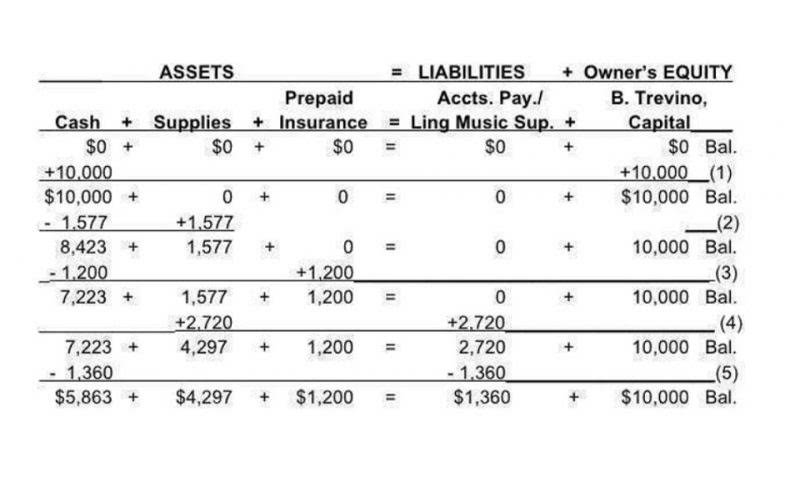
For instance, a company might maintain a subsidiary ledger for each customer to track individual sales and payments. This granularity is invaluable for businesses that need to manage large volumes of transactions, as it allows for more efficient monitoring and reconciliation of accounts. Subsidiary ledgers also help in identifying discrepancies and ensuring that the general ledger remains accurate and up-to-date. The posting date is integral to cash flow management, influencing how effectively a company navigates its financial obligations and opportunities. Accurate cash flow forecasting relies on timely recording of transactions.
How is the Balance Column Used in the General Ledger?
- At the end of a period, the T-account balances are transferred to the ledger where the data can be used to create accounting reports.
- Accurate and up-to-date records enable businesses to monitor their cash flow effectively, ensuring that they have sufficient funds to meet their obligations.
- Regular staff training ensures your accounting team stays updated with the latest processes, software, and regulatory requirements.
- A subsidiary ledger would contain details of the rent expenses, including a line item per month debited in “Rent” and credited in “Accounts Payable”.
- Your business should have clear guidelines for recognizing revenues, expenses, and other transactions at every period-end.
- Debit and credit balances are to be entered into the general ledger as per the balance in the account.
This flexibility is https://www.bookstime.com/ critical for multinational corporations navigating diverse tax jurisdictions and reporting standards. Explore how posting dates influence financial management, affecting statements, cash flow, and reconciliation processes. This ensures that all adjustments, reconciliations, and entries are completed before closing the books, allowing for accurate financial reporting. In conclusion, post-accounting is essential for maintaining accurate, organized, and reliable financial records. Posting accounting definition enables the company to know the balance of each account on a particular date.

Ensure Proper Documentation
For instance, recurring transactions like monthly rent or utility payments can be automatically posted to the appropriate accounts, saving time and effort for accountants. It ensures that all assets and liabilities are to be recorded properly. The balances of nominal accounts are directly transferred to the profit and loss account. The balances related to balance sheet items are to be transferred to the general ledger account. It helps keep the updated records, but with the advancement of technology and the availability of various software, the posting in balance has become the traditional concept. This can happen when a transaction is recorded in the journal but not posted to the ledger.
What are Post Journal Entries?

Thomas Richard Suozzi (born August 31, 1962) is an accomplished U.S. politician and certified public accountant with extensive experience in public service and financial management. He is known for his pragmatic approach to fiscal policy and governance. The general ledger for each net sales period is to be maintained separately to avoid double balancing or mess in the accounts. Transfer in general ledger takes place with the name of the account and amount carried forward in subledger or general journal along with entry details. Well-trained staff can better handle complex transactions, spot errors, and follow best practices.
- By following these procedures, you avoid misstatements and ensure accurate financial reporting.
- This type holds the category for lifeless things or relating to assets/ properties like machinery, land etc.
- Posting is the transfer of journal entries to a general ledger, which usually contains a separate form for each account.
- This is particularly important for small and medium-sized enterprises, where cash flow issues can have significant repercussions.
- Automated accounting systems, such as QuickBooks and Xero, streamline the transfer of journal entries to ledgers, reducing the likelihood of human error.
- As previously mentioned, the first step in the accounting cycle is the collection of the source document, and the second step is recording the journal entries.

Using accounting software and automation tools for automated bookkeeping and invoice processing reduces any potential manual errors and speeds up transactions. Post-accounting refers to the systematic process of finalizing and reconciling financial records after the end of an accounting period. In that case, a deposit account, rent account and inventory account will be made with Rs. 7000 debit balance, Rs. 2000 as credit balance and Rs. 2500 as credit posting accounting balance respectively. Therefore, the total calculates by deduction of credit balance from debit, providing the figures for further analysis or financial statements.
Posting in Accounting Examples
- The data is segregated on basis of type, into accounts for liabilities, assets, revenue, expenses and owner’s equity.
- By posting these entries to their respective ledgers, accountants can maintain a clear and detailed record of all financial activities.
- Further elaborated states that credit the things that go out while debit the ones that come to the company.
- Each account, such as Cash, Accounts Receivable, or Sales Revenue, provides a running balance for that specific financial element.
- This is crucial for meeting short-term liabilities without facing liquidity crunches.
- Modern accounting systems, such as ERP solutions like SAP and Oracle or platforms like QuickBooks and Xero, have transformed how posting dates are managed.
The general ledger is the primary ledger in accounting, encompassing all the individual accounts that summarize the financial transactions of a business. Each account within the general ledger represents a specific aspect of the business, such as assets, liabilities, equity, revenues, and expenses. This detailed categorization allows for precise tracking and analysis of financial performance. For example, the accounts payable ledger will track all outstanding debts, while the accounts receivable ledger will monitor incoming payments. The procedure of transferring an entry from a journal to a ledger account is known as posting. It consists of the date, the name of accounts affected LF note (that tells the page number of the ledger), debit and credit amounts.
Company
Postin accounting definition gives an updated status of all the ledger balances. Moreover, it aids in tracking the balances on the records of how it has changed over some time. The T-account shows the opening and closing balances as well as the individual transactions during the period covered. As previously mentioned, the first step in the accounting cycle is the collection of the source document, and the second step is recording the journal entries.
- By leveraging automation, businesses can focus more on strategic financial planning and less on the minutiae of manual data entry.
- It captures every financial event chronologically, ensuring a detailed, date-ordered history of each transaction.
- While journals record the chronological flow of individual transactions, the general ledger aggregates these entries to show the cumulative impact on each account.
- An entry in accounting is when you record a transaction in the journal, capturing details like the date, accounts, and amounts this is called journalizing.
- When each entry is posted its ledger account the journal entry number is usually placed next to the entry in the T-account.
- For example, if a company sells goods on October 15, 2023, that date is recorded as the transaction date, regardless of when the payment is made or received.
The financial statements represent a summary of business operations, cash flows and financial position over an accounting period. The accounting journal serves as the initial record for all financial transactions a business undertakes. It captures every financial event chronologically, ensuring a detailed, date-ordered history of each transaction. Journal entries include the date, the specific accounts affected, and the corresponding debit and credit amounts. A brief description of the transaction is also included, providing context. The journal’s purpose is to provide a complete sequence of all business dealings before they are categorized into accounts.

Posting Journal Entries to the Ledger(T-Accounts)
The next step is posting, where you transfer these entries to the relevant accounts in the general ledger for analysis. Regular reconciliation ensures the accuracy of your company’s financial statements, supports better financial decision-making, and gives you confidence during audits or financial reporting. Your business faces challenges like a large volume of financial data, accuracy during data entry and compliance with regulations. Post-accounting is the process where you post your business transactions in relevant accounts maintained.
